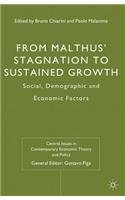
From Malthus' Stagnation to Sustained Growth: Social, Demographic and Economic Factors(Central Issues in Contemporary Economic Theory and Policy)
Series: Central Issues in Contemporary Economic Theory and Policy
In recent years it has become apparent that the pattern of population growth is consistent with the predictions of the Malthusian model. Studies on the pre-industrial epoch in a wide range of countries show positive income elasticities of mortality and a strong positive correlation between real wages and marriage rates. Negative shocks to population, such as the Black Death, were reflected in high
NaN
VOLUME
English
Hardback

In recent years it has become apparent that the pattern of population growth is consistent with the predictions of the Malthusian model. Studies on the pre-industrial epoch in a wide range of countries show positive income elasticities of mortality and a strong positive correlation between real wages and marriage rates. Negative shocks to population, such as the Black Death, were reflected in higher real wages and faster population growth. Moreover, the prediction of the Malthusian model that differences in technology should be reflected in population density, but not in standards of living, is also borne out. However, the empirical implications of the Malthusian model are more complex than simply a tendency of real wage to revert to its long-run equilibrium level together with slow population growth. Many factors have impinged on the fertility and mortality rates. A most striking feature of the preindustrial epoch is the simultaneous effect of contradictory forces. This volume studies these forces pushing towards both growth and poverty, and evaluates the utility of the Malthusian model as a tool for understanding demographic dynamics today.
Price Comparison [India]
In This Series
Bestseller Manga
Trending NEWS




















